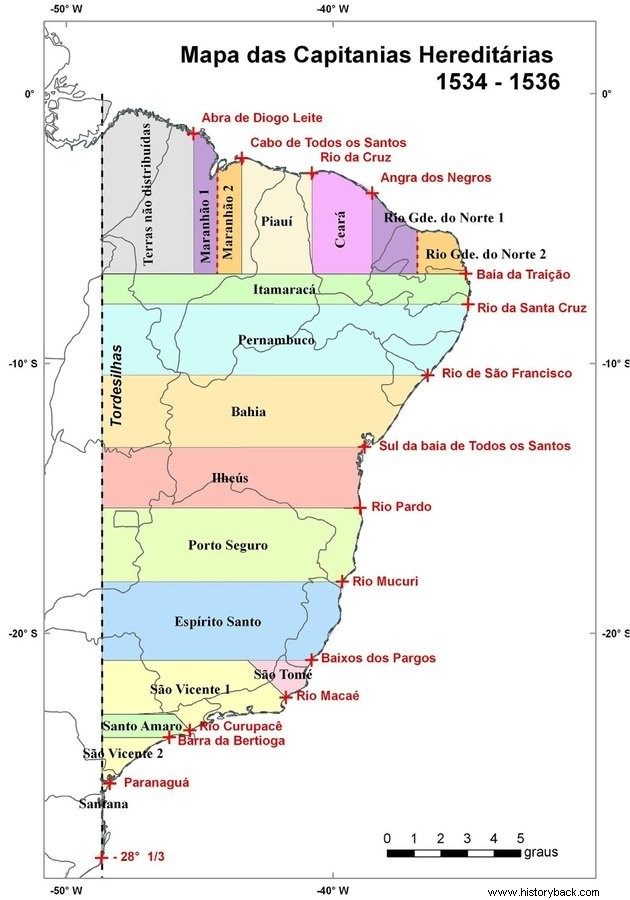The Hereditary Captaincies were an administrative system implemented by the Portuguese Crown in Brazil in 1534.
The territory of Brazil, belonging to Portugal, was divided into strips of land and granted to the trusted nobles of King João III (1502-1557). These could be passed from father to son and that's why they were called hereditary.
The main objectives were to populate the colony and divide the colonial administration. Hereditary Captaincies, however, were short-lived and were abolished sixteen years after their creation.
Summary on Hereditary Captaincies
After the discovery of lands to the east of the Treaty of Tordesilhas in 1500 by Pedro Álvares Cabral, the focus of the Portuguese Crown in its colony of Portuguese America was the extraction of resources from the land, such as pau-brasil.
This was due to the fact that no precious metals were found as was the case with the Spaniards in their possessions.
The system of hereditary captaincies was implemented after the expedition of Martim Afonso de Sousa, in 1530. The Portuguese were afraid of losing their conquered lands to other Europeans who were already negotiating with the indigenous people and were looking to settle there.
To this end, the Portuguese Crown immediately adopted measures to populate the colony, thus avoiding possible attacks and invasions.
The captaincy system had been implemented by the Portuguese on Madeira Island, in the Azores and Cape Verde Archipelagos.
Thus, the creation of 15 captaincies and their 12 grantees was established, since some received more than a portion of land and the Captaincies of Maranhão and São Vicente were divided into two portions.
Read more :
- Treaty of Tordesillas
- Pau-Brasil Cycle
- Colonial Brazil
Hereditary Captaincies Map

Below is the name of each and their respective grantees:
- Maranhão Captaincy:João de Barros and Aires da Cunha and Fernando Álvares de Andrade
- Captaincy of Ceará:Antônio Cardoso de Barros
- Rio Grande Captaincy:João de Barros and Aires da Cunha
- Itamaracá Captaincy:Pero Lopes de Sousa
- Captaincy of Pernambuco:Duarte Coelho Pereira
- All Saints Bay Captaincy:Francisco Pereira Coutinho
- Captaincy of Ilhéus:Jorge de Figueiredo Correia
- Porto Seguro Captaincy:Pero do Campo Tourinho
- Captaincy of Espírito Santo:Vasco Fernandes Coutinho
- Sao Tomé Captaincy:Pero de Góis da Silveira
- Captaincy of São Vicente:Martim Afonso de Sousa
- Santo Amaro Captaincy:Pero Lopes de Sousa
- Santana Captaincy:Pero Lopes de Sousa
Rights and Obligations of the Grantee
King Dom João III granted the lands to trusted nobles. Each Donatory Captain was considered the highest authority, being responsible for populating, administering, protecting the territory, founding villages and developing the local economy. For its part, the Portuguese Crown did not give any financial assistance to the grantees for this undertaking.
The grantees, on the other hand, had some legal and fiscal privileges such as:
- enslave indigenous people;
- collect taxes and donate uncultivated land plots (sesmarias);
- explore the region and enjoy all its natural resources (a percentage of which belonged to the crown), from animals, wood and ores.
Despite having great power, the captaincies did not belong to the grantees, but to the Portuguese Crown, which charged a tax called “tithe”, that is, 10% of the captaincy's production.
However, the captaincy system suffered from a lack of resources, some were abandoned and in others their grantees were never there. They also suffered attacks from indigenous people, who were fighting against the invasion of their lands.
In this way, the enterprise of hereditary captaincies failed. Only two were successful:
- Captaincy of Pernambuco, commanded by Duarte Coelho, responsible for introducing the cultivation of sugar cane;
- Captaincy of São Vicente, commanded by Martim Afonso de Sousa, thanks to the traffic of indigenous people who carried out in those lands.
After the hereditary captaincies became unfeasible, the colony underwent an administrative reform and the General Government was instituted.
Curiosities about Hereditary Captaincies
- The hereditary captaincies boosted the growth of villages, which gradually became provinces, and later constituted some Brazilian states.
- The legacy of the hereditary captaincy system can still be felt today through coronelismo and the families that continue to maintain power in certain states.
- Martim Afonso de Sousa remained in his captaincy for a short time, as he was transferred to occupy a post in the Indies. Who managed the land was his wife, Ana Pimentel.
We have more texts on the subject for you :
- History of Pernambuco
- Sugar Cane Cycle
- First capital of Brazil - Salvador
- Exercises Colonial Brazil
- Duarte da Costa
- Sugar Mills in colonial Brazil
